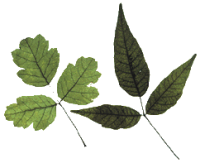Poison Ivy and Poison Oak
 Overview
Overview
In some people, plants such as poison oak, ivy, sumac, primrose and ragweed can cause a severe allergic reaction (contact dermatitis) when the oils from the bark, stems, leaves, flowers or fruit come in contact with the skin or are inhaled. Some species of plants are also poisonous when they are consumed.
Most (but not all) people are sensitive to the irritating oil called urushiol that is found in these plants. It is not known why some individuals seem to be relatively or completely immune to poison ivy and oak.
Symptoms of Poison Ivy and Poison Oak
The allergic symptoms of contact dermatitis can vary greatly from one person to the next but usually start with itching and burning. Then the skin begins to swell, a rash spreads over the body, and blisters form that may ooze.
In severe cases, systemic symptoms may manifest themselves and can include generally feeling ill, fatigue, sleep disorders and discomfort in general.
The symptoms of internal poisoning from eating such plants depend on the plant but usually include rash, difficulty swallowing, confusion, blurred vision and possibly even coma. Less severe symptoms can include flushing and hyperactivity. Plants are most poisonous in the spring and early summer but can also be a problem when dried or at other times of the year.
Occurrence
These poisonous plants account for about 350,000 cases of contact dermatitis per year in the U.S. Young children are most commonly afflicted because they play in patches of poisonous plants or eat the colorful berries. All children should be taught at a young age not to eat wild plants and how to distinguish the ones which are poisonous. Poison oak, ivy and sumac grow as bushes or vines and have three leaflets (ivy and oak) or a row of paired leaflets (sumac).
Prevention
The best treatment for cases of poison oak and ivy are prevention. In other words, learn how to identify these poisonous plants and avoid them when walking in areas where they are common. Wear protective clothing.
Some people who are especially sensitive to these plants can be exposed by petting animals that have been through patches of poison oak or ivy.
Any clothing that has come in contact with the plants should be thoroughly washed. Sometimes cases of poison oak and ivy that will not go away are caused by the infected clothing or bedding still being in place, allowing the condition to continue.
Very hot showers can spread the rash and increase the itching, so if a mild case is suspected avoid this type of bathing.
Treatments for Poison Ivy and Oak
Many over-the-counter treatments are available for the severe itching associated with poison ivy and oak. Not one of these will shorten the length of the outbreak. Most, however, make the itch more bearable.
Anyone with a severe case or one that involves the face should seek help from a medical professional. Some immediate relief can be gained by injections or prescription medicines given by a physician. Anyone who has not seen a doctor and the condition is not better by the end of two weeks should seek professional help.
In the early stages of the outbreak, apply cold compresses to the affected areas. Cold stops itch. An ice pack or a towel soaked in ice water can be used. If a large area of the body is stricken with poison ivy or oak, soak in a tub filled with very cool water.
In the dry, later stages of the dermatitis, do not use calamine lotion. Apply hydrocortisone cream, lotion or ointment several times daily. This cream takes away the redness, itch and dryness.
Natural Treatments
Some of the products that can be consumed for nutritional therapy for this type of dermatitis include:
A poultice can be made using equal parts of witch hazel, white oak bark, mugwort and plantain.
The affected area can also be rinsed with apple cider vinegar and goldenseal. Also, frequent warm baths containing apple cider vinegar or cornstarch can be helpful.
Some topical products that alleviate the condition include witch hazel, aloe vera gel, a paste of activated charcoal powder or a paste made of baking soda and witch hazel.
Soapwort can be used for washing the affected area. Some natural therapists believe that plants containing the compounds known as saponins might work better than soap and water in helping to minimize the effects of urushiol.
Some other plants containing saponin include licorice, horse chestnut, seneca snakeroot, soapbark, rose leaves and gotu kola. Note: the TOPICAL use of these plants is suggested, not their ingestion.
References
- Balch, J.F. & Stengler, M. (2004). Prescription for Natural Cures: a self-care guide for treating diseases and health problems with natural remedies including diet and nutrition, herbal medicine, nutritional supplements, bodywork, and more. New Jersey: John Wiley and Sons Ltd
- De Vries, J. (1992). Skin diseases. Edinburgh : Mainstream
- Goodman, T. (1984).The skin doctor's skin doctoring book.New York : Sterling
- Papadopoulos, L. (2003). Understanding skin problems : acne, eczema, psoriasis and related conditions. Chichester, West Sussex : John Wiley and Sons Ltd
- Turkington, C., (1998). Skin deep : an A-Z of skin disorders, treatments and health. New York : Facts On File
Posted in Poison Ivy and Poison Oak
Ask a Question Or Join a Discussion


